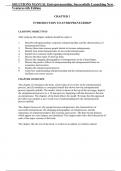Examen
Solutions Manual For Entrepreneurship, Successfully Launching New Ventures 6th Edition by Bruce Barringer, Duane Ireland
- Cours
- Établissement
Solutions Manual Entrepreneurship, Successfully Launching New Ventures 6th Edition by Bruce Barringer, Duane Ireland ISBN13: 9780136878681. Entrepreneurship 6e solutions.
[Montrer plus]



